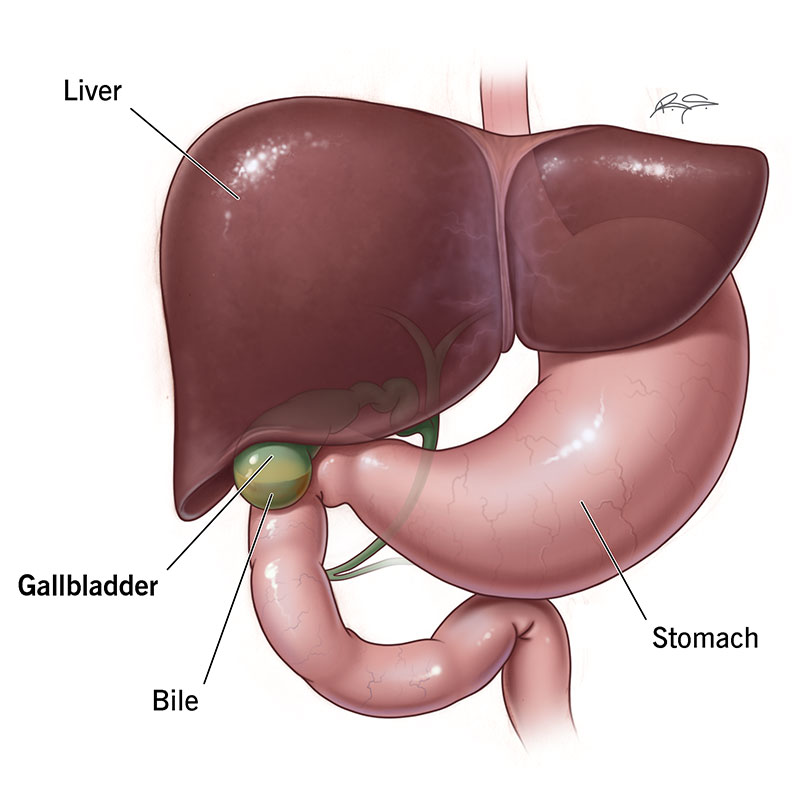Your gallbladder is a small, pear-shaped organ located under your liver that stores and releases bile. Bile is the fluid your liver produces that helps digest fats in the food you eat.
Advertisement
Cleveland Clinic is a non-profit academic medical center. Advertising on our site helps support our mission. We do not endorse non-Cleveland Clinic products or services. Policy

Your gallbladder is a small, pear-shaped organ that stores and releases bile. Bile is the fluid your liver produces that helps digest fats in the food you eat.
Advertisement
Cleveland Clinic is a non-profit academic medical center. Advertising on our site helps support our mission. We do not endorse non-Cleveland Clinic products or services. Policy
Your gallbladder is located in the upper right part of your abdomen (belly). It sits just under your liver.
Your gallbladder is part of your digestive system. Its main function is to store bile. Bile helps your digestive system break down fats. Bile is a mixture of mainly cholesterol, bilirubin and bile salts.
Your gallbladder is connected to other parts of your digestive system through a series of bile ducts called the biliary tract. The biliary tract (sometimes called biliary system or biliary tree) is a pipe-like system that carries bile from your liver to your small intestine.
Before you start eating, your gallbladder is full of bile. When you start eating, your gallbladder receives signals to contract and squeeze the stored bile through the biliary tract. The bile eventually finds its way to your largest bile duct, the common bile duct. Bile passes through the common bile duct into the duodenum, the first part of your small intestine, where it mixes with food waiting to be digested. After you eat, your gallbladder is empty and resembles a deflated balloon, waiting to be filled up again.
Several conditions can cause problems in your gallbladder. The most common condition is gallstones. Gallstones are typically harmless but can sometimes lead to disease states. Gallbladder diseases include:
Advertisement
The symptoms of gallbladder problems vary. Some people don’t feel gallstones or even know they have them. But if gallstones block the flow of bile, they can affect your gallbladder or pancreas. You may experience the following symptoms:
Most gallbladder issues are treated with the removal of your gallbladder. Surgery to remove your gallbladder is called a cholecystectomy. Your gallbladder is not an essential organ. This means you can live a normal life without a gallbladder. When a surgeon removes your gallbladder, bile will flow out of your bile ducts directly into your digestive system instead of being stored in your gallbladder first.
Surgeons can perform cholecystectomies three ways:
People who are overweight — especially women — are more likely to develop gallstones. This is because people who are overweight may have more cholesterol in their bile. More cholesterol in your bile can cause gallstones. People who are overweight may also have bigger gallbladders that don’t work as well. Losing weight too quickly may raise your chances of forming gallstones as well. But slowly losing weight may help you prevent them.
Advertisement
Your gallbladder was not essential, but it did help you digest fatty foods. Immediately after gallbladder removal, you’ll want to avoid fried and greasy foods.
After surgery, fat calories should make up no more than 30% of your diet. Take your time reintroducing high-fiber foods such as whole grains, nuts, seeds and vegetables. They may cause severe bloating and gas if you eat them too quickly.
Your gallbladder is a small, pear-shaped organ in your upper right abdomen. Your gallbladder stores and releases bile to help your digestive system break down fats. The most common issue you may develop with your gallbladder is gallstones. Gallstones are pebble-like objects made from bile material. Most people don’t even know they have them, and most of the time they will not cause a problem. If you have upper right abdomen pain after eating fatty meals, nausea, vomiting, jaundice or fever, talk to your healthcare provider. If your gallbladder is found to be the culprit, you may need your gallbladder removed, which is OK — it’s not an essential organ, and removing it may make you feel better.
Advertisement
Cleveland Clinic’s primary care providers offer lifelong medical care. From sinus infections and high blood pressure to preventive screening, we’re here for you.

Last reviewed on 07/28/2021.
Learn more about the Health Library and our editorial process.